Homer Laughlin Exhibit at Grave Creek Mound
LaurelHollowPark.net, an informative website created and
maintained by Mark Gonzalez. Copyright © 2009-.
|
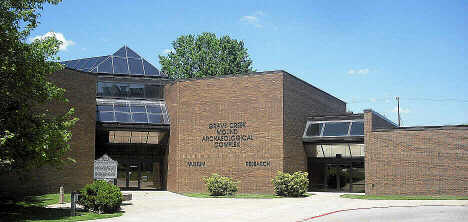 For the past several years, the Grave Creek Mound Archeological Complex in Moundsville, West Virginia has been home to an extensive exhibit of wares made by the Homer Laughlin China Company. Behind protective glass are over 300 examples of Homer Laughlin pieces spanning the 20th Century.
For the past several years, the Grave Creek Mound Archeological Complex in Moundsville, West Virginia has been home to an extensive exhibit of wares made by the Homer Laughlin China Company. Behind protective glass are over 300 examples of Homer Laughlin pieces spanning the 20th Century.
Besides the dinnerware, a video presentation on Homer Laughlin with emphasis on methods of production and a time line can be viewed at the complex. The display has a wide array of pieces from decaled examples to vintage and contemporary Fiesta®. There are some commonly found pieces as well as some rare one-of-a-kind experimentals.
Special thanks must go to Charles Morris of the West Virginia Division of Culture and History and to Andrea Keller, Cultural Program Coordinator for allowing me to photograph the exhibit and share it here.
When in the area, be sure to visit Grave Creek Mound. Besides Homer Laughlin, there are exhibits on Ron Hinkle Glass , Marble King, and more. Their website can be viewed by following this link: Grave Creek Mound Archaeological Complex.
|
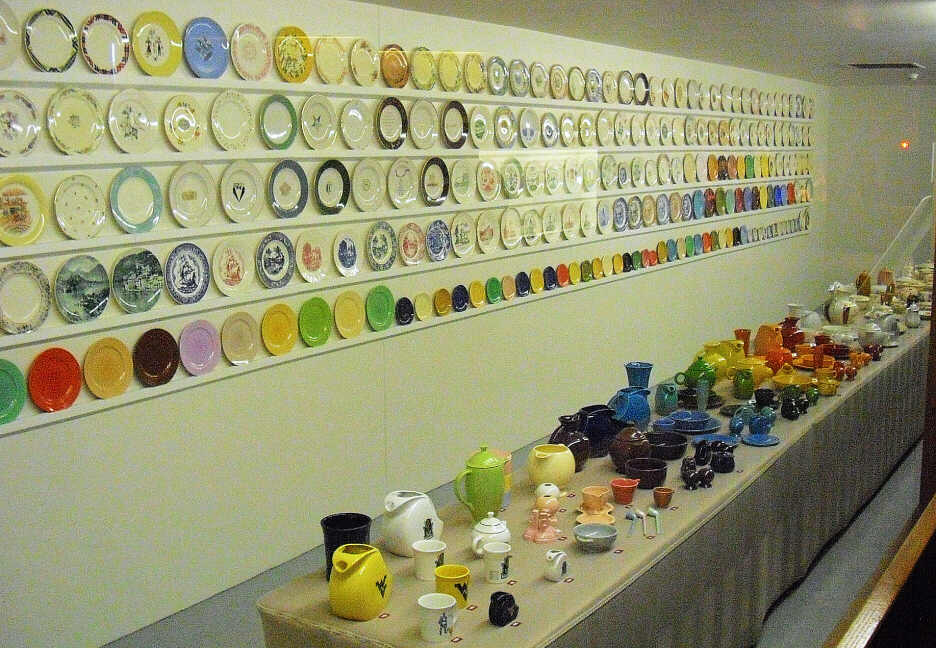
The Homer Laughlin Exhibit at Grave Creek Mound |
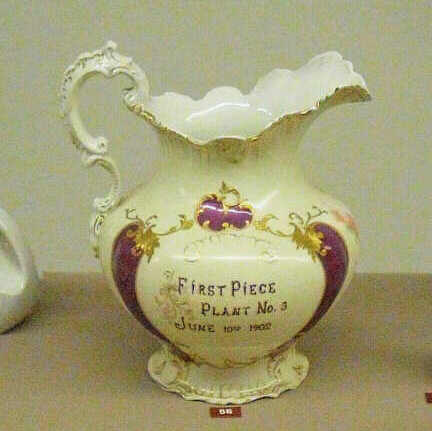
|
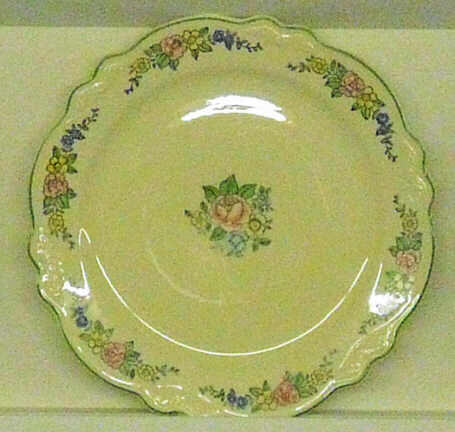
|
|
The Wyoming shape pitcher on the left was the first piece made at plant number 3 on June 10, 1902 in East Liverpool, Ohio. This is one of the few pieces on display that came from the East Liverpool, Ohio plants. Everything else was made in Newell, WV. On the right is a Virginia Rose shape 10" plate with decals and green trim from the 1930s.
|
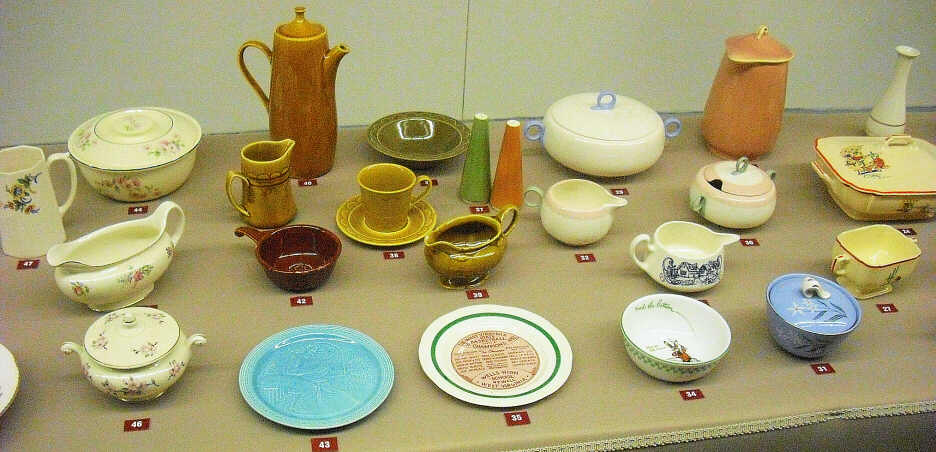
|
|
The coffeepot in the back and towards the left is a bit unusual with its gold glaze. It comes from the Vogue shape which was mostly decorated with decals and exterior colored glazes with lids in contrasting white. This is the first all over solid color example of Vogue I've seen. The Virginia Rose creamer in the center was also given an all over glaze. Such creamers, along with the sugars, are quite rare. To the right are a few pieces of Swing from the late 1930s. The covered gravy with notched lid can be hard to find.
|
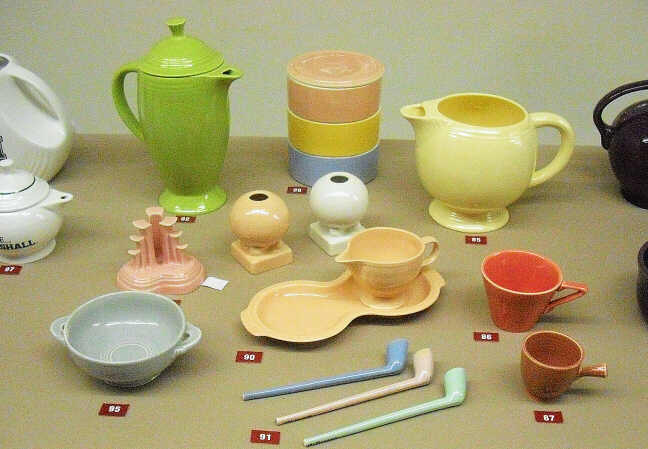
|
|
Some vintage and contemporary Fiesta® pieces. The stack set is from the seldom seen Chromatic OvenServe line -- essentially Kitchen Kraft shapes with exterior colored glazes. The pipes in front are experimental pieces.
|
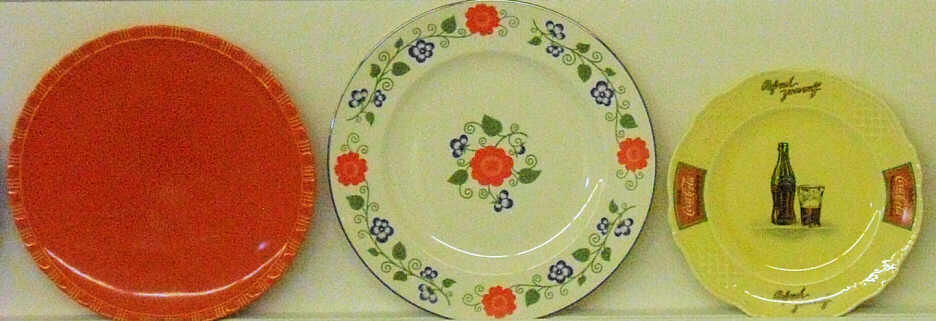
|
|
On the left is a 9" experimental plate which, according to company records, was based on a Wedgwood design. It was created in September of 1939 and glazed in Fiesta® red. The example in the center is a decaled Cavalier dinner plate. To the right is a Trellis plate from circa 1930 with a light yellow glaze and Coca-Cola advertising. Similar pieces made by other potteries (namely the Taylor, Smith & Taylor Co. of Chester, WV) with Coca-Cola decals sell for between $200 and $500.
|

|
|
The plate on the left and in the middle are from an underglaze transfer line called Famous Old Ships. This line was created in the early 1940s and never went into production. The blue plate is the Nautilus shape complete with sea shell border. The plate in the middle is the Theme Eggshell shape with the same ship transfer, but in red. I've heard of Famous Old Ships pieces before, but this was the first time I'd seen them up close.
|
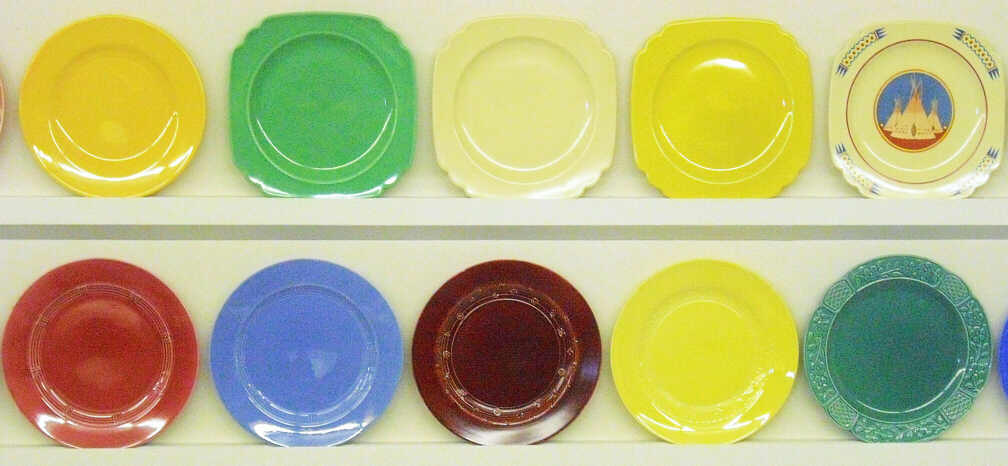
|
|
Top row: yellow plain shape plate. Riviera plates in green, ivory, and yellow. Decaled Century plate, "Crow" pattern from a Native American series.
The first four plates in the bottom row are Harlequin prototypes. They differ from the regular plate in that there are small, periodic embossings on the rings. Eight different Harlequin plates were considered in the summer of 1936 until it was decided the simple ring pattern without added embellishment would serve as a basis for the line. Shown are models 614 - with crisscross embossing and model 624 - with floral sprigs embossing. The green plate on the far right is an experimental piece unrelated to Harlequin.
|
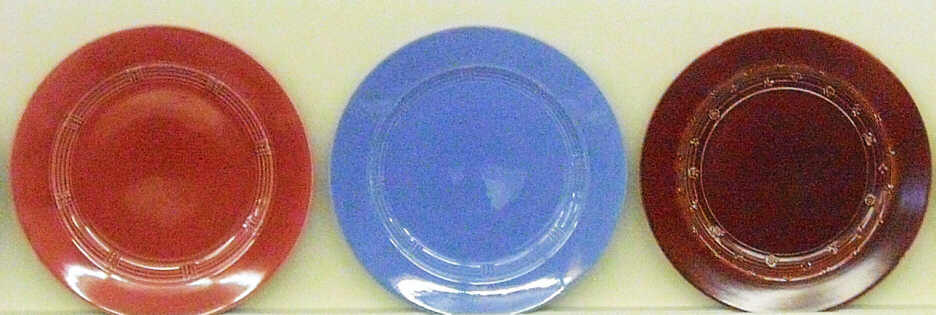
Harlequin prototype plates: model 615 in dark rose and blue glazes, model 624 in maroon. |
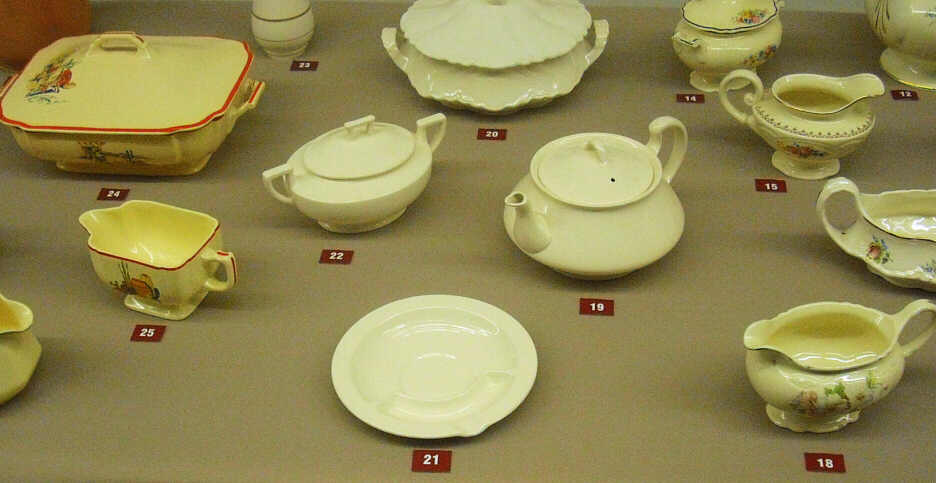
|
|
Focus on this picture is the Harlequin ashtray in the center. This is listed in the exhibit key as ivory, but looks more like a clear glazed example. Also shown is an Hacienda casserole (24), Mexicana creamer (25), Kwaker sugar (22), Empress teapot (19), Marigold creamer (15), Virginia Rose creamer (18), and a Republic casserole (20).
|
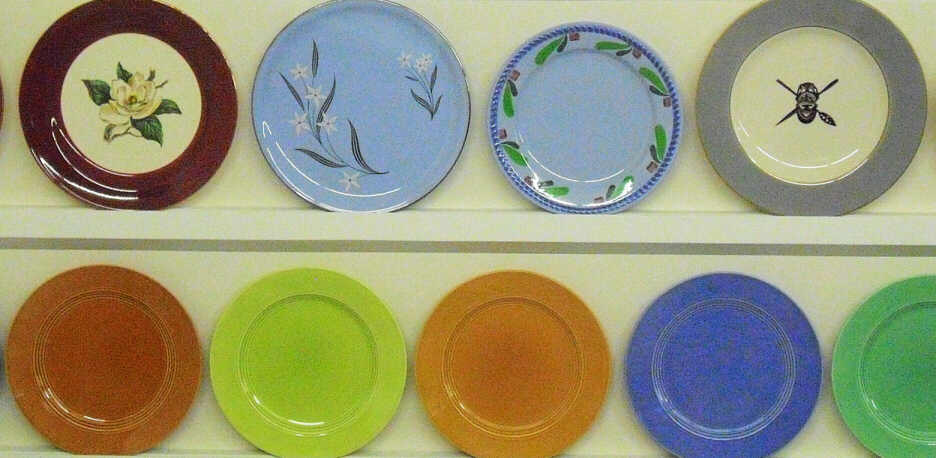
|
|
Top row, left to right: Magnolia 10" plate, decaled Skytone 10" plate, Kraft Blue 9" plate with hand-painted decoration (possibly one-of-a-kind), Trader Vic's restaurant ware 10" plate. Bottom row, Harlequin plates in assorted glazes.
|
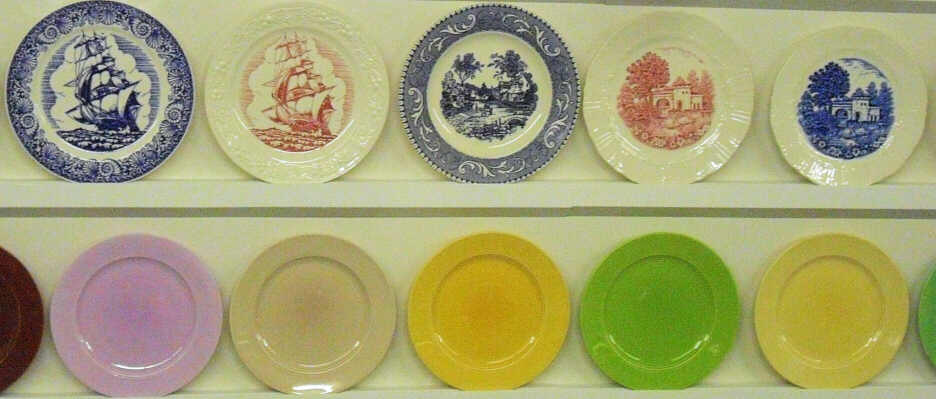
|
|
Underglaze transfer examples on the top row with a few Harlequin plates in experimental glazes below: orchid, tan, Harlequin yellow (a standard glaze), lime, and a pastel yellow.
|
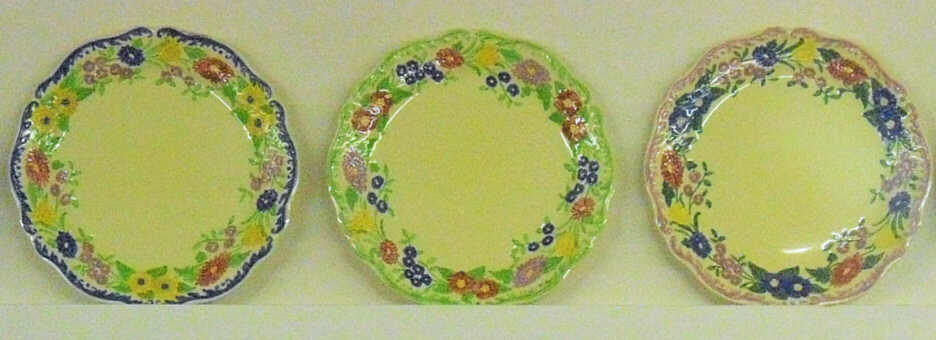
Experimental scalloped shape plates with elaborate hand-painted details. |
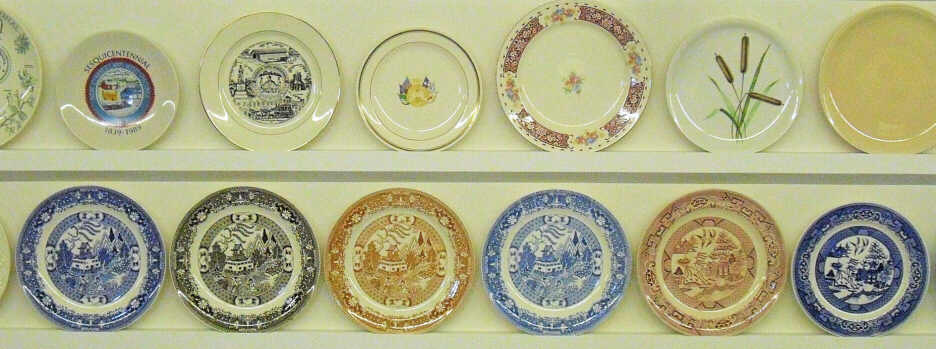
|
|
The plates on the bottom row feature a Willow underglaze transfer design. While HLC made Willow in blue and pink, the black version as well as the tan example in the center are unusual and more than likely weren't mass produced.
|
|
|